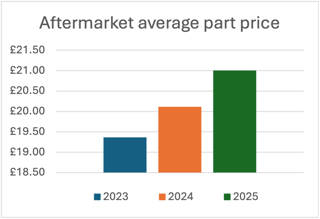The paper VED disc is to be abolished, removing an administrative inconvenience for franchised dealers and millions of motorists.
It has been supersded by an electronic system, which will allow motorists to pay their VED by direct debit from October 2014, for a 5% administration fee.
In addition, the statutory maximum price of the MoT test for a car will be frozen at £54.85 until 2015.
And the planned fuel duty increase for September 2014, expected to be worth 1.61p per litre, will be cancelled, said Chancellor George Osborne in the Autumn Statement today.
In total, fuel duty will have been frozen for nearly four and a half years, the longest freeze for over 20 years.
The Treasury says that this means that it currently costs the typical motorist £7 less to fill up their tank, and will cost £11 less by the end of the Parliament.
In total, the Government claims it will have eased the burden on motorists by £22.5 billion over this Parliament. This equates to a saving of £680 for a typical motorist, £1,300 for a small business with a van, and £21,000 for a haulier by 2015-16.
Osborne told the House of Commons: “Britain’s economic plan is working, but the job is not done. We need to secure the economy for the long term.”
The Office for Budget Responsibility (OBR) has revised its forecast for GDP growth up from 0.6% to 1.4% in 2013 and from 1.8% to 2.4% in 2014. It has also forecast GDP growth of 2.2% in 2015, 2.6% in 2016 and 2.7% in 2017 and 2018.
From 2012 to 2018, the OBR has revised up cumulative real GDP growth by 1.4 percentage points.
It also expects the rate of inflation to slow between 2013 and 2016, returning to the 2% target in the second half of 2016.
Osborne says the Government remains on course to meet the fiscal mandate one year early, with the cyclically adjusted current balance reaching a surplus of 1.6% of GDP in 2018-19.
Public sector net borrowing as a percentage of GDP is forecast to have halved by 2014-15.
Excluding the effects of the transfers to and from the Asset Purchase Facility, public sector net borrowing is forecast to be in surplus by 0.1% of GDP in 2018-19.
Public sector net debt as a share of GDP is forecast to peak at 80% of GDP in 2015-16 – a year earlier than forecast at Budget 2013, but a year later than the supplementary target for debt – before falling each year and reaching 75.9% of GDP in 2018-19.






















Neil Addley - 05/12/2013 15:26
As expected, the statement hasn’t told us anything we didn’t already know. Osborne has kept to his earlier promise of freezing fuel duty until 2015, which goes some way towards supporting motorists, but does not tackle the already vastly inflated prices we are forced to pay at the pump in order to keep our vehicles on the road. We commissioned a survey prior to the Statement which showed an overwhelming majority of the UK population (79.9%) would choose a cut in duty on fuel over any other tax costs including alcohol (8%) and cigarettes (6.8%). Coupled with research* which shows 64% of SMEs said a significant cut in fuel duty would help increase their profits, and one in 10 having to make staff redundant because of sky high fuel costs, I fail to understand just how Mr Osborne can claim he is still doing everything he can to aid UK business in achieving economic recovery. I feel Osborne’s statement that ‘where we can afford to help hardworking families, we will continue to do so’ misses the point when the cost of fuel impinges on what is often a vital lifeline for individuals, particularly the poorest, erodes business margins and weakens national competitiveness with European countries, most of whom have a far lower fuel duty rate. Cutting fuel duty by 10p per litre would put almost £300 back into the average motorist’s pocket every year, helping out those for whom fuel is a vital necessity.